In the world of classic menswear, spectators are certainly one of the more visually-arresting styles and, indeed, they’re also known by other names including “correspondent shoes” and, sometimes, “spats.” But, what exactly are they? We discuss the distinctive footwear today, and discover why you’ll likely find them in a classic menswear enthusiast’s wardrobe!
Defining Spectator Shoes
In the most general terms, a “spectator” is a shoe that is made in two contrasting colors. It can be styled as an Oxford, a derby, a loafer, or even a monk strap, and it can feature broguing as well.
Most typically, the toes and heels are going to be finished in a darker color and the upper quarters are going to be finished in a contrasting, lighter color. However, the reverse can also be true and these are typically known as “saddle shoes.” But, we’ll get into that in greater detail later on.
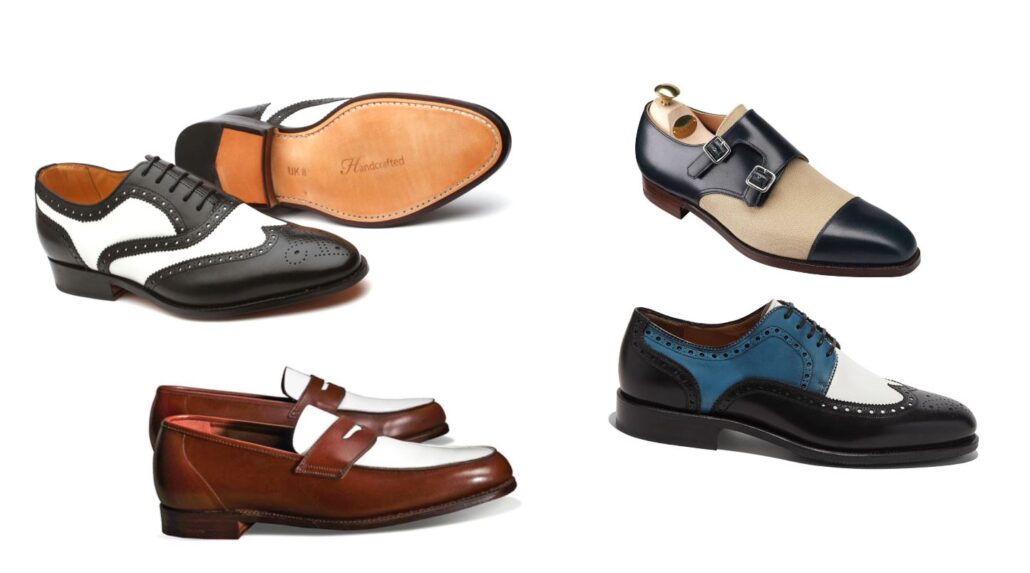
As we mentioned, though, they do go by multiple names. In the United States, they’re most commonly called “spectator shoes” as they have an association with sporting events. They were originally worn by athletes but later came to be worn by those watching the sporting events, much as one might wear a pair of Air Jordans to a basketball game today. Thus, they became known as “spectator shoes” for the spectators of the sports.
Meanwhile, in the UK, the style has historically been called the “correspondent shoe,” and it has a bit more of an unsavory story behind it. As a stark contrast to the smart and sober, black Oxford shoes worn by the typical English gentleman, correspondent shoes were worn often by cads and dandies. More specifically, this has its origins in British divorce law, where the co-respondent is the person with whom a married individual would be committing adultery.
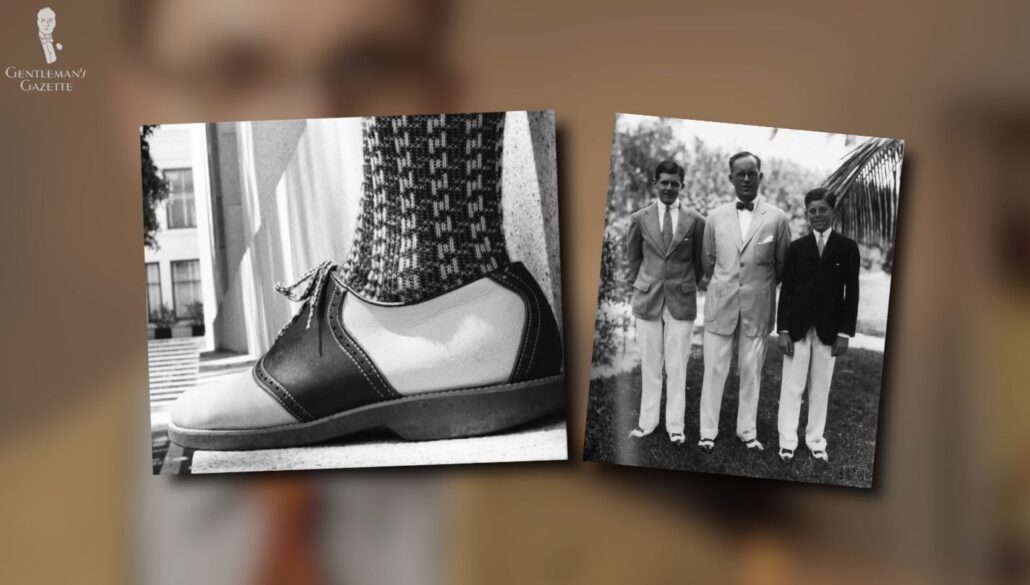
Therefore, “co-respondent” became a shorthand for the caddish men who would chase and seduce married women. But, as the word can also refer to the different corresponding colors on the shoes, this became a punny way for them to be referred to as “correspondent shoes.”
You will occasionally see them referred to as “spats,” but this is a misnomer as “spats” or “spatter dashes” are separate pieces of material that are affixed to the tops of shoes to keep them cleaner in dirty or rainy environments. It’s easy to see where the confusion comes from though as spats can also give that two-toned appearance.
Why did men stop wearing spats?
History of Spectator Shoes
The history of this specific shoe type is actually somewhat murky and highly contested. They’re often credited to the famous British shoemaker John Lobb. It’s said that Lobb came up with the idea for the shoes in 1868 for use by cricket players.
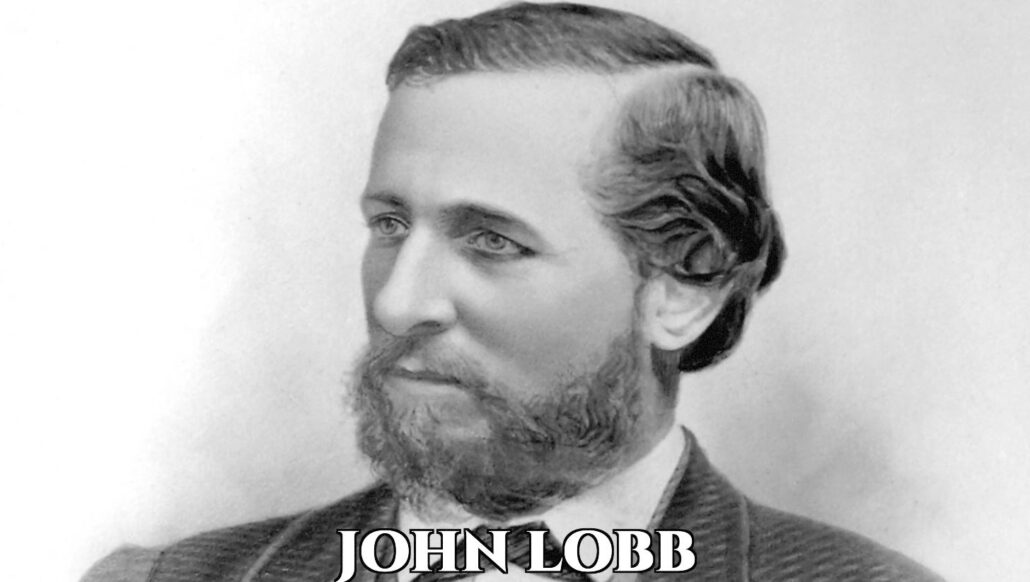
Sports fans may know that cricket shoes are typically all white to go along with the rest of the uniforms, which are collectively known as “cricket whites.” These all-white clothes and shoes can show dirt easily, however, so it’s said that lob took the areas of the shoes that would most frequently get dirty, the toes and heels, and made them in a contrasting, darker material.
This story is nice, but it doesn’t stand up to historical scrutiny; at least, if the specific date of 1868 is to be believed. Looking at illustrations and photographs from the time, we can see that athletes were wearing shoes like these earlier, as here in 1864, and that British cricketers were wearing black boots in the 1850s.
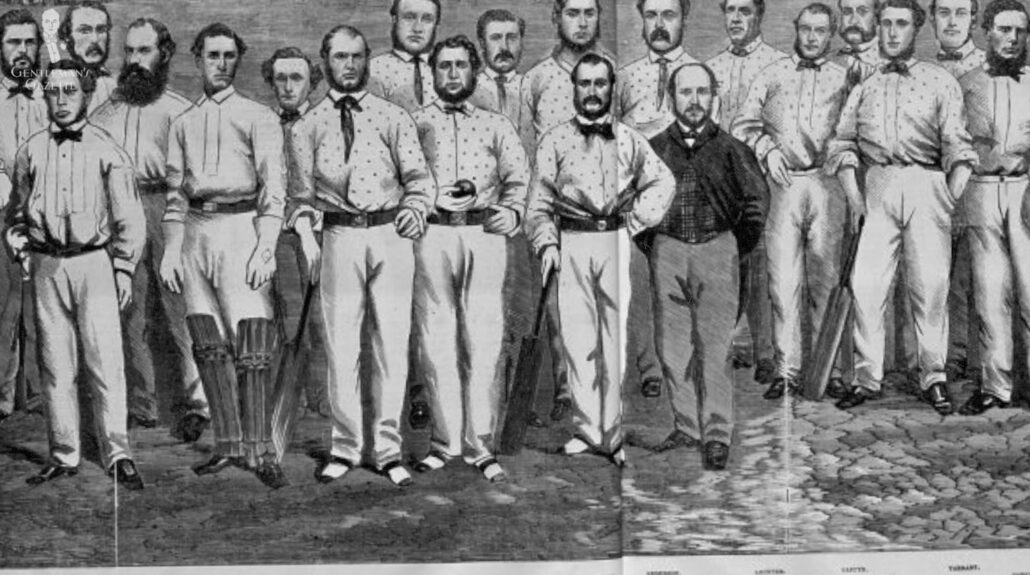
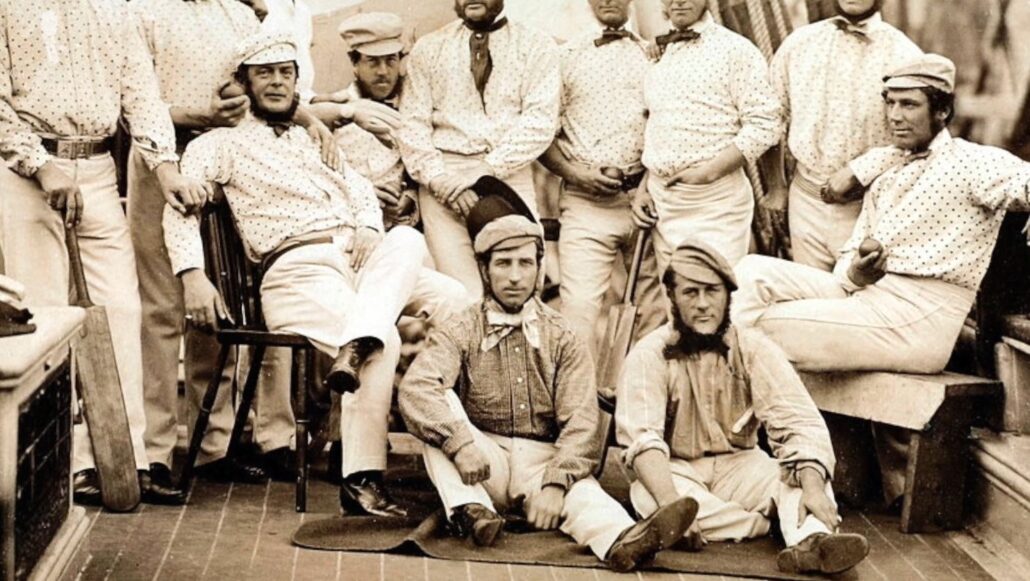
As we can see in various photographs and illustrations from the 1840s, 50s, and 60s, all different kinds of shoes were being worn for sports from white to black to brown and multicolored and everything in between. If we fast forward a bit to the 1880s, we can see famous tennis players, like the Renshaw Twins, wearing shoes that are closer in style to what is said to be Lobb’s creation.
But, considering that two-toned shoes for both cricket and tennis came in a variety of styles, it’s more likely that they simply came about to harmonize in a nice way with the cricket whites or, perhaps, to emulate earlier styles of trousers that had stirrups at the bottom.
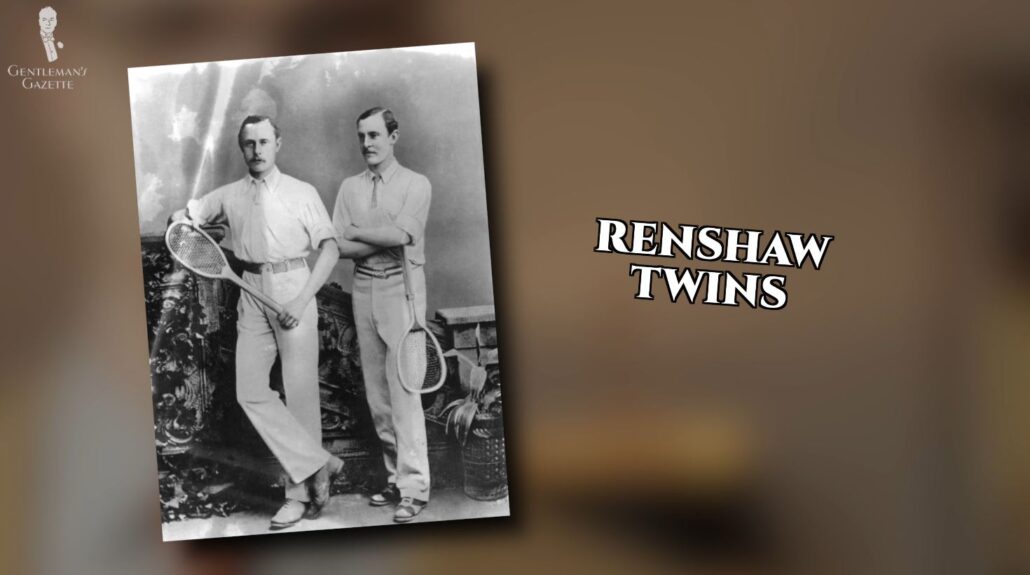
So, we may never know the whole story here, but it is a matter of record that two-tone shoes like these were in use as early as the 1860s. And, indeed, two-toned footwear has appeared at several points even further back in history, so it is impossible to say just where the style was first worn.
A well-known period of two-toned footwear that preceded the spectator was the Victorian Era, where button boots with contrasting uppers became popular. You can see a two-toned button boot being worn in this illustration from 1859, which, of course, is again earlier than when Lobb supposedly invented the spectator.
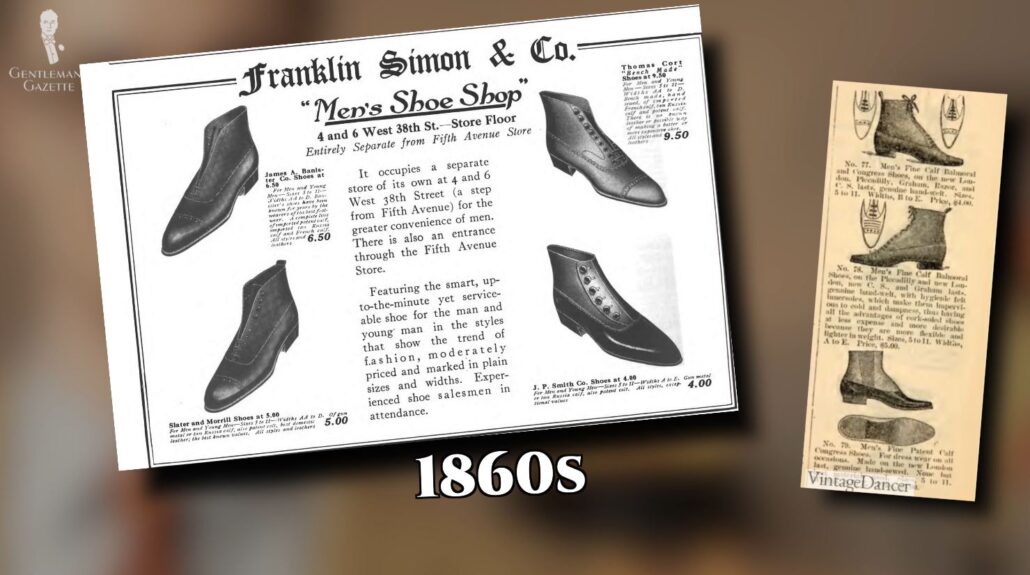
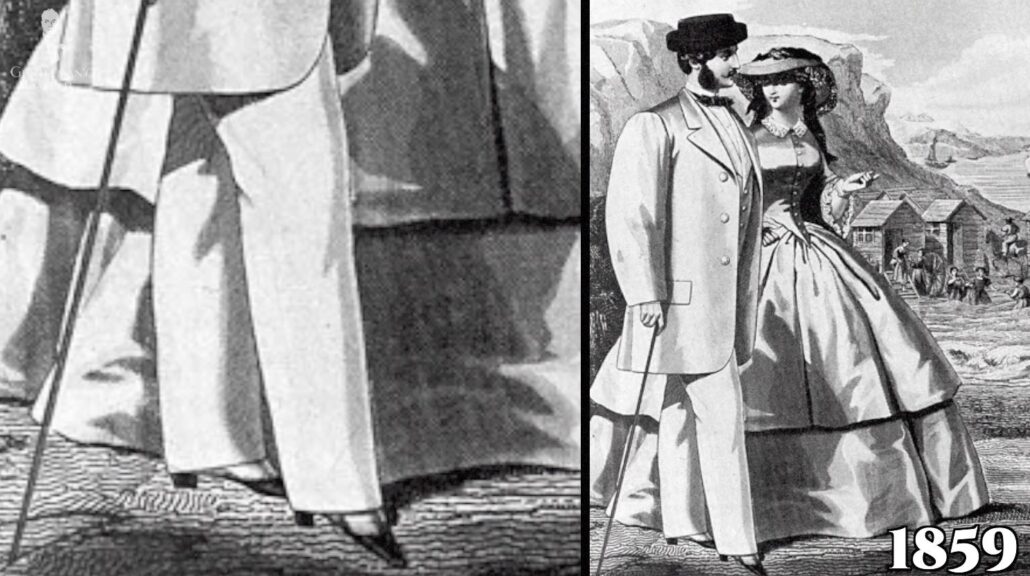
In later decades, these would come in a multitude of colors, especially in America, where designs could be particularly expressive. Laced boots with contrasting upper quarters were also popular and both of these styles were staples in the fashionable gents’ wardrobe up until the 1920s or so.
1900s
By the 19-oughts, two-toned shoes were commonly being worn for spring and summer ensembles as they were more comfortable in warmer weather than the taller boot styles. You can see examples in the Spalding catalog from 1906. This, by the way, was the same year that Spalding invented the so-called “saddle shoe,” where, instead of the toe and heel being darker in color, an additional piece of leather was sewn over the top of the shoe (also called a “saddle”) to make the shoe more structurally sound.
These new saddle shoes were worn alongside spectators as athletic footwear for decades to come and, by the 20s and 30s, saddle shoes and spectator shoes were the sporting shoes of choice for the well-dressed. They were featured in traditional leather as well as in other styles that incorporated materials like canvas. They were easy to wear, comfortable, and long-lasting, so, just as saddle shoes and spectators became popular with athletes, they were also frequently worn as dancing shoes.
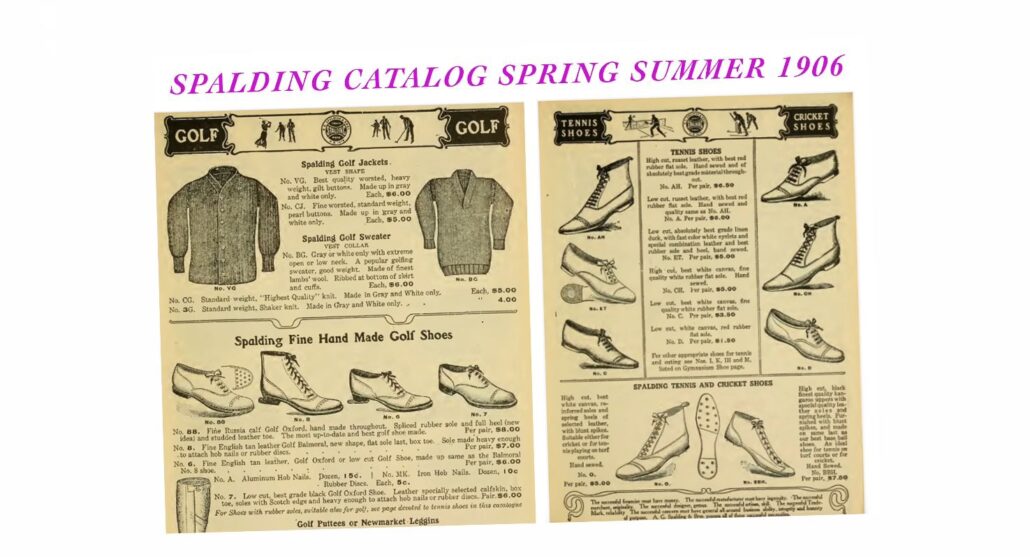
By the 20s and 30s, then, many of the most popular dance crazes that originated in this time would probably have been dance in spectators. And because African-American musical artists were making their way into the mainstream around this time, it’s also sometimes stated that teens would wear spectator shoes to show their support for racial harmony between black and white.
By the 1930s, most cricket players had gone back to the traditional, all-white shoe, but because sports fans were showing up in their two-tone shoes, this is around the time that the “spectator” term came into fashion. The spectator can be seen as something of the sneaker of its day, and it was worn by all types of people from gambling men and gangsters, all the way up to royalty.
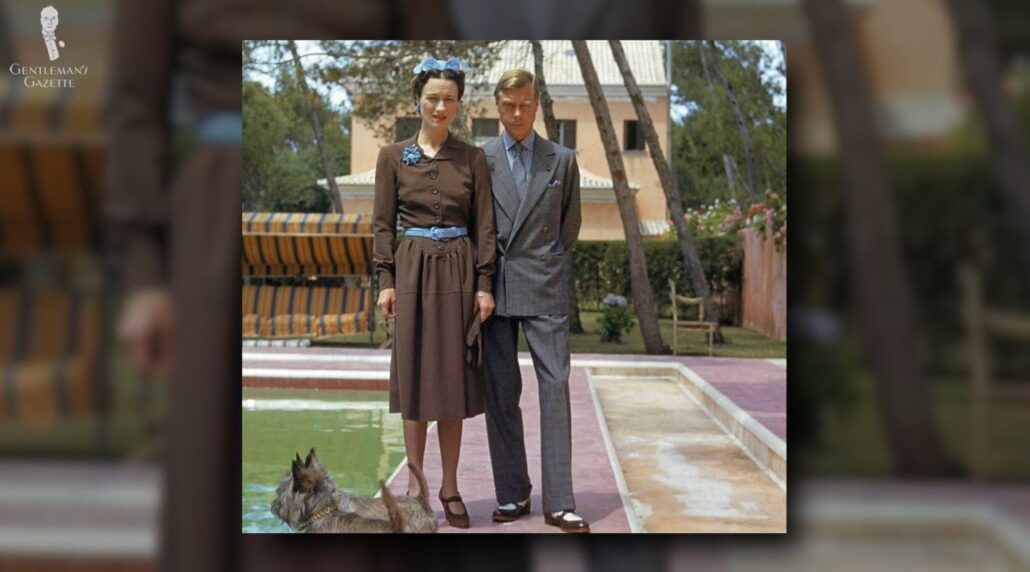
Ever the clotheshorse, Edward VIII pushed this shoe past its old reputation as being only for cads and brought it fully into the mainstream. He wasn’t the only one, however, as Hollywood stars like Fred Astaire also did their part to popularize the shoe.
Modern Spectator Shoes
The spectator shoe remained popular even through the hard times of the Great Depression. But, at the advent of the Second World War, when rationing became mandatory and people were more somber overall, it started to fall out of favor. And while spectator shoes have continued to be made ever since, they never really regained their mainstream status after World War II.
Because of this and their immense popularity during the 1920s and 30s, spectator shoes worn today do necessarily carry a bit of a vintage feel overall. What’s more, given that they were often worn by unscrupulous characters, they also developed a bit of a reputation as the “gangster shoe.” You needn’t look any further than the introductory sequence for HBO’s Boardwalk Empire to see what we mean here.
The reality, though, is that even during these past decades, far more everyday people would have owned pairs of spectator shoes and they weren’t just reserved for these troublesome folks. Indeed, when done well, the spectator is a wonderful addition to any classic menswear wardrobe.
However, if you happen to have searched for them yourself, you’re likely to have been bombarded by a wide array of ready-to-wear options across the internet. As we’ve discussed many times on the website, though, quantity rarely equals quality and many of these options are going to be mass market, ready-to-wear varieties made from lower-quality materials and with inferior construction techniques; not to mention, designs of questionable attractiveness.
What To Look For In Quality Spectator Shoes
Firstly, classic menswear and leather go hand-in-hand, which means that practically all high-quality spectator shoes are going to feature leather in at least some portion of their construction. Typically, this is going to be more in the highly-structured areas of the shoe, such as the toe, heel, and instep, where the laces are found.
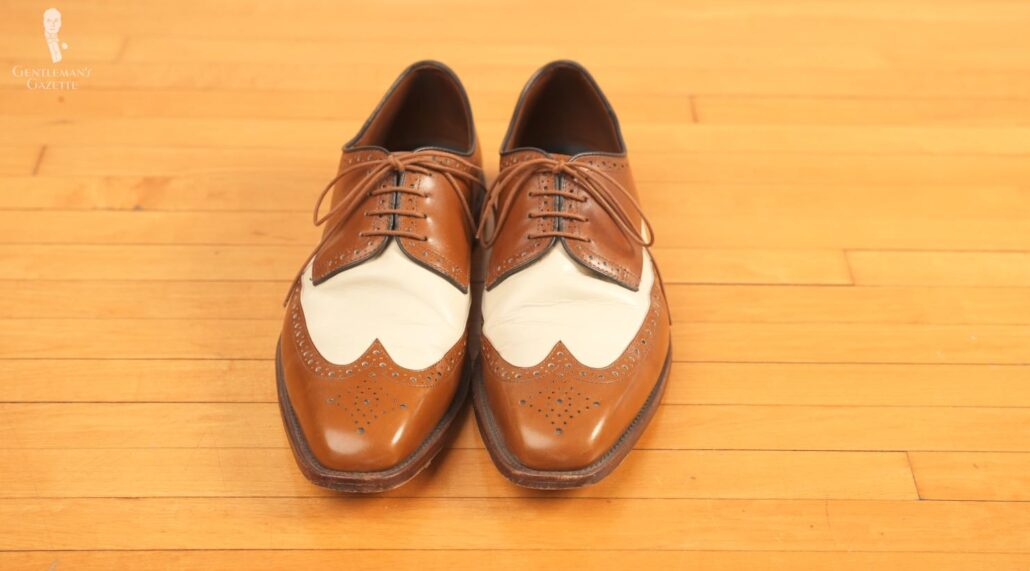
It’s entirely possible to find pairs of spectator shoes crafted entirely from leather, just like any other style of dress shoe. Even with the signature two-tone styling of the spectator, there are no hard and fast rules about the materials that need to make it up, however. If you like the feel of an all-calfskin dress shoe, you can certainly buy a spectator in this style, but that needn’t be your only option.
1. Common Materials
The styling of the spectator then provides a great opportunity to experiment with other types of materials, so we’ll run down some of the most common choices.
Buckskin
Let’s start off with buckskin. Traditionally, brilliant white buckskin was used as the material of choice in the majority of spectator shoe uppers. This crisp, white buckskin contrasted beautifully with the corresponding dark calfskin portions of the shoe, creating the quintessential spectator look.
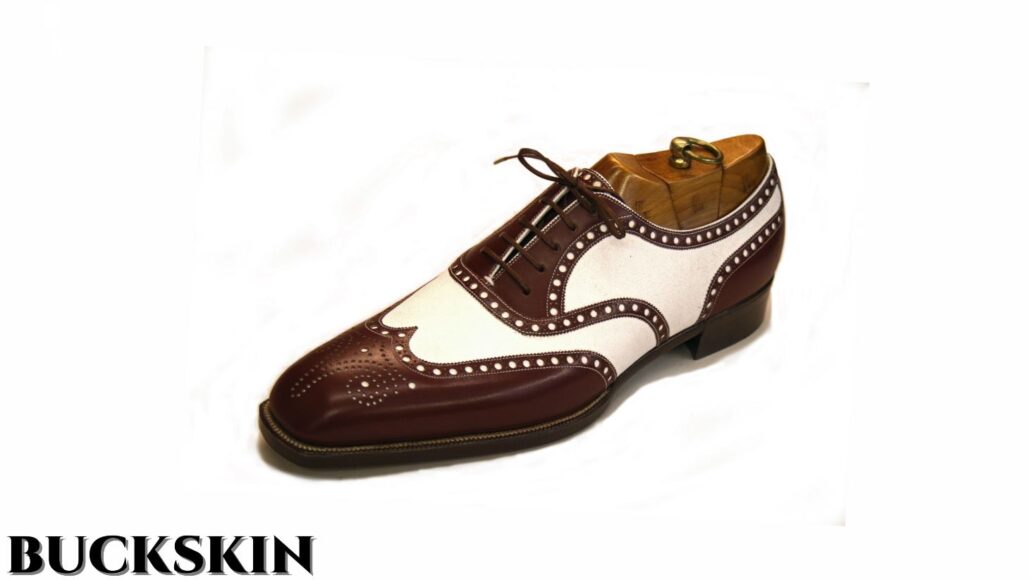
That being said, buckskin is less common in spectators these days and, while a few artisanal makers will still use it in their ready-to-wear offerings, you’re more likely to find buckskin in bespoke spectator shoes.
Canvas (Colonial Style)
Spectators utilizing canvas are often referred to as the “colonial style” as this was the material of choice for British Colonials in the tropics. Even today, canvas has replaced buckskin somewhat as the go-to material for spectator uppers. While it’s stylistically similar to buckskin, canvas is an even better choice for spectators worn in warm weather as it’s more breathable for your feet.
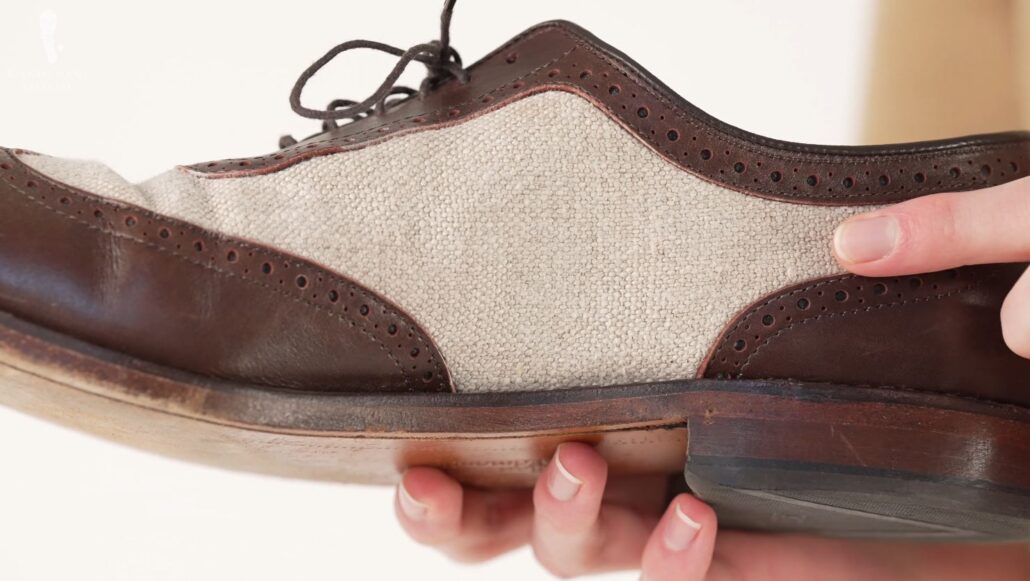
Other Fabrics
Aside from canvas, spectators featuring other kinds of fabric can also be found, such as the herringbone pair I own. Keep in mind, though, that these can often be more on the high-fashion, bold side, so you’ll want to balance them out with more muted elements elsewhere in your ensemble.
Suede
Meanwhile, spectators featuring suede have a softer and more casual feel both literally as well as aesthetically. They also have the bonus of being a wonderful choice for those who like the look of a wingtip shoe, but find it a bit too formal in its all-leather variety.
By selecting a suede in a similar or, indeed, identical color as the leather of the shoe, a subtler contrasting effect can be achieved by contrasting the textures rather than the colors.
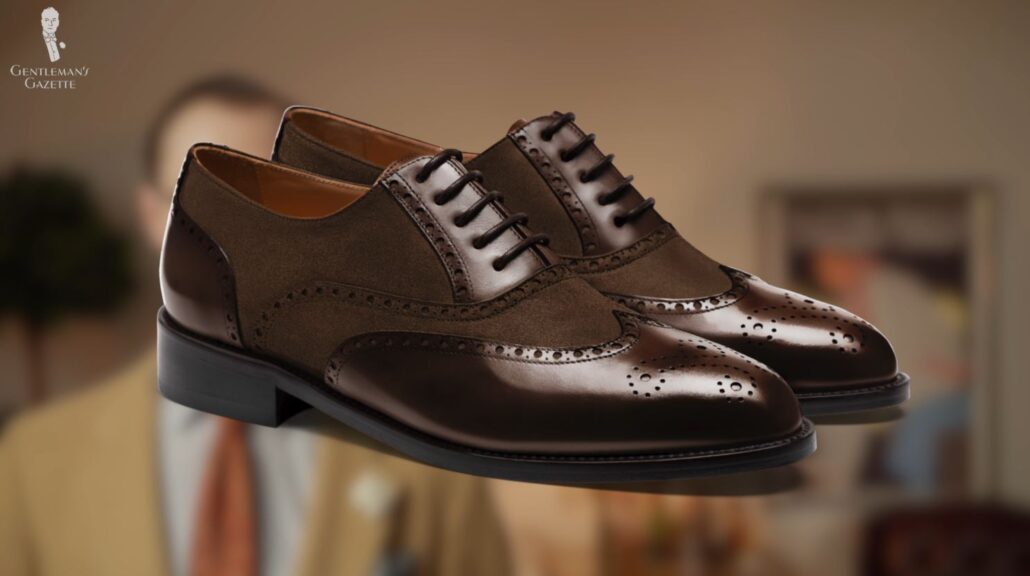
2. Colors
Let’s next discuss the most common colors you’re going to find for spectator shoes. Classic colors include brown and white, black and white, brown and tan, and burgundy and tan or white. However, as we mentioned previously, black and white spectators, specifically, are often associated with gangster costumes even if they’re not seen in gangster movies often.
With this in mind, then, we would strongly recommend that you go with a different color combination for your first pair of spectators, unless, of course, you’re truly dead set on the gangster look.
Nowadays, you can also find spectators in a multitude of different colors, including rainbow-like designs. And although they can be quite fun to look at, they can also be difficult to pair well with other elements of your wardrobe, and they run the risk of looking a bit clownish.
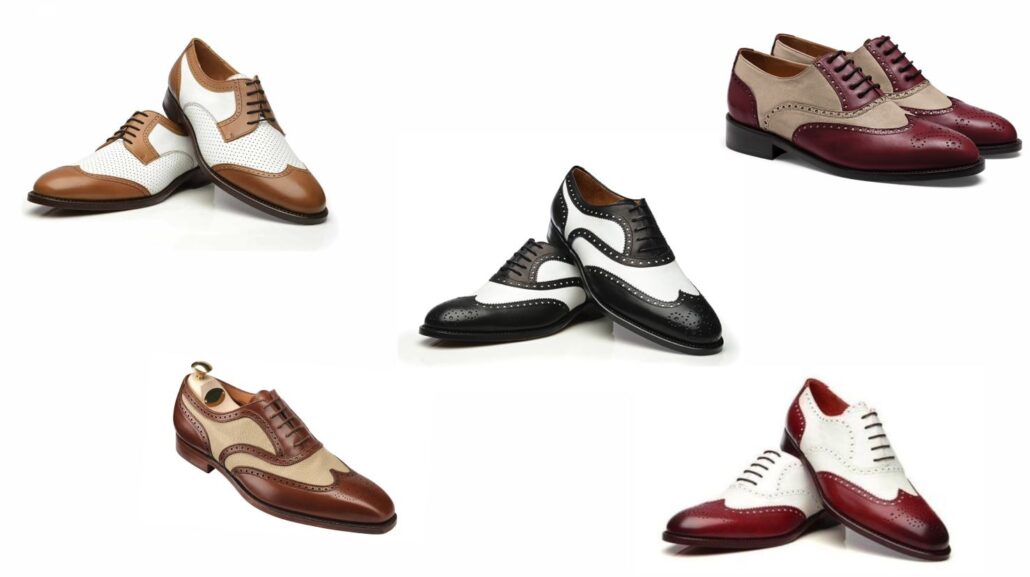
By the way, if you’re interested in overly colorful or flashy dress shoes and whether or not they have a place in a gentleman’s wardrobe, we’ve covered that subject on a previous post.
Overall, then, we’ve found that selecting a pair of spectators in brown or burgundy tones will provide you with the greatest amount of versatility. Clean, contrasting white portions will provide you with the highest amount of vintage appeal and choosing an off-white or tan upper will provide a more subtle appeal and a more timeless edge.
3. Broguing
Aside from the fact that spectators are made with different materials and in different colors, you may also have noticed that they come with different amounts of decorative broguing. Like all traditionally casual shoes, spectators can come as a full-brogue or wingtip, as well as a semi or half-brogue, and a quarter-brogue.
There are also plain styles of spectators without any broguing, but we’ve found that it’s easier to incorporate brogue styles into your wardrobe as the non-brogue styles will have a tendency to look more like a specialist dance shoe than a piece of a typical menswear wardrobe.
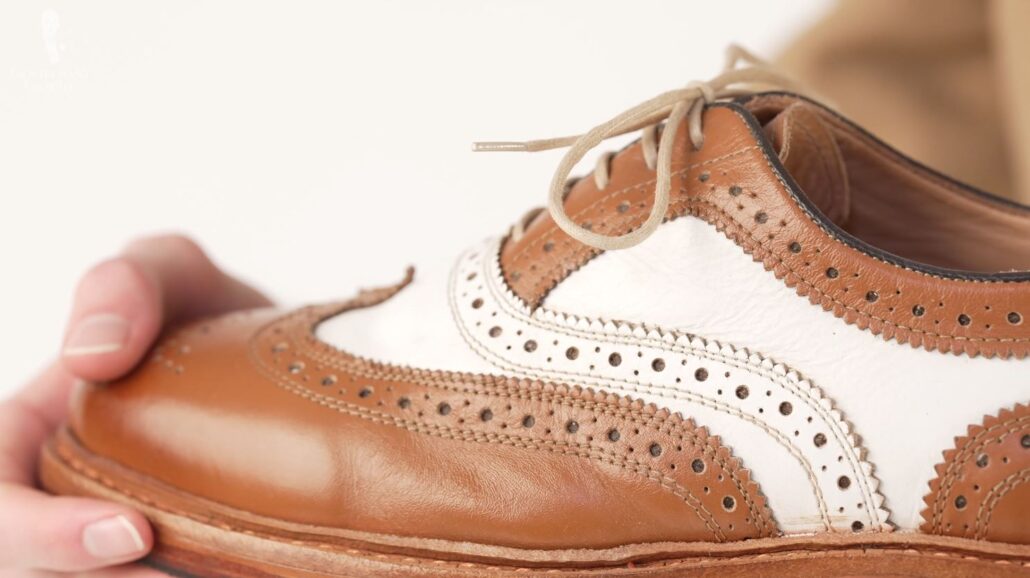
Essentially, you can think of the broguing as helping to soften and casualize the look of the shoe overall. What’s particularly fun about spectators though is that, much like the material choices and color options, there are also no hard and fast rules on how much broguing you should have.
So, you can go for a modern and minimalist approach or you can pull out all the stops with broguing galore. Whichever you choose though, know that spectators and broguing are timelessly twinned.
Conclusion
Despite its history and origins as a casual shoe, the overall casualization of menswear and dress over the second half of the 20th century means that spectators are going to be seen more as a formal shoe today. Of course, the same can be said for any elegant style of shoe with a slim sole, at least when compared to a pair of Balenciagas. Although Raphael would still probably want to play a game of cricket in spectators, there are better options when it comes specifically to sporting shoes available today.
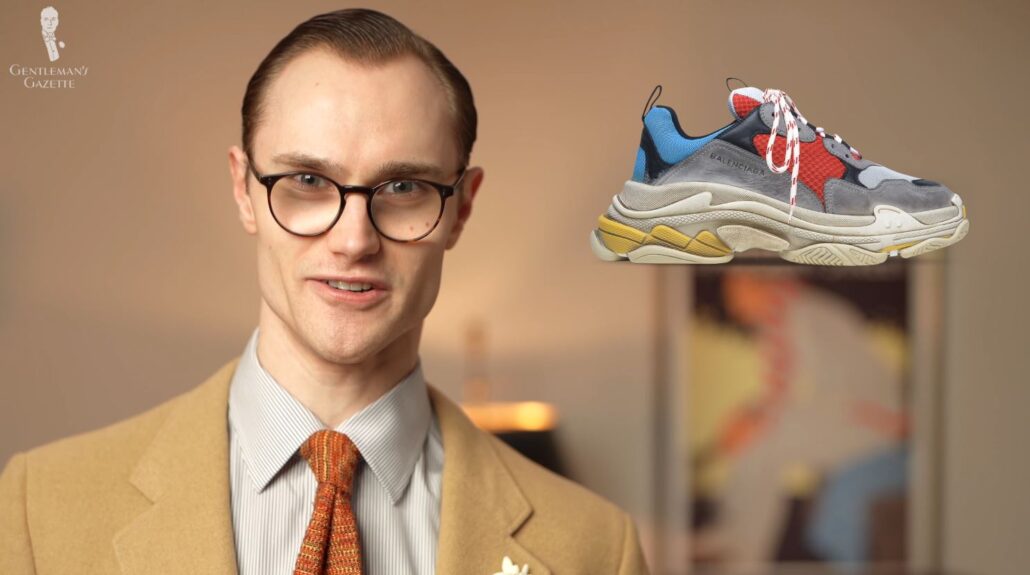
We believe then that spectators are best enjoyed today as part of a classically-inspired menswear wardrobe and, in particular, with warm weather ensembles in the tradition of scorpacciata or savoring seasonal dressing.
With this in mind, spectators pair wonderfully with summer fabrics, like linen cotton and seersucker, and the brighter tones of summer ensembles go well with the two-toned look of a spectator shoe.
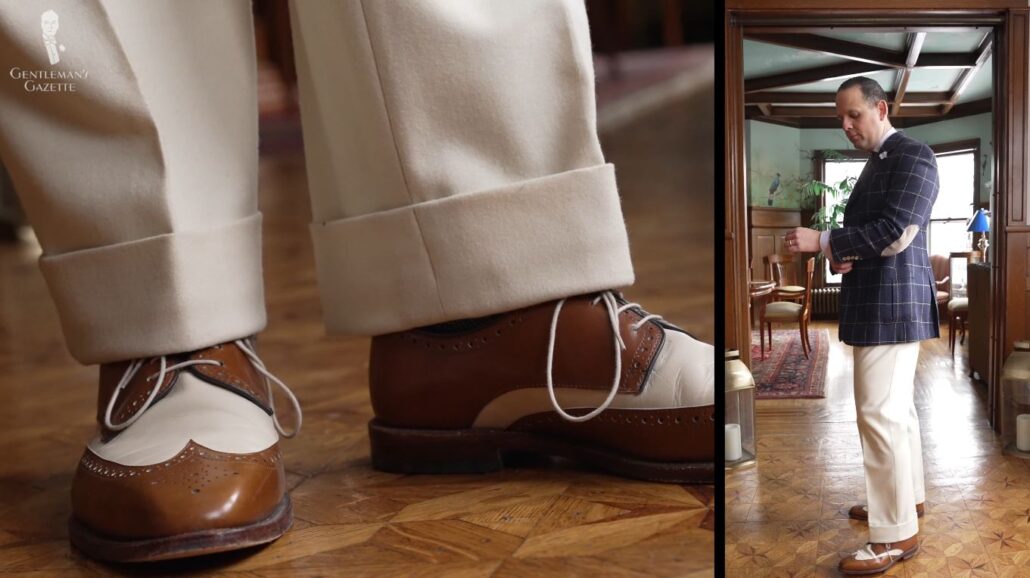
With that being said, though, a high-quality pair of spectators should be just as sturdy as any other well-made dress shoe, so you can increase the seasonal range in which spectators can be worn. By combining them with heavier fabrics like corduroy or flannel, you’ll see that they can be worn equally well in transitional seasons like spring and fall.
Whichever route you decide to go, we’d suggest that you pair your spectators with combinations of odd jacket and trousers rather than full suits. Partly, this will dispel the gangster connotations, but also, as spectator shoes are inherently more casual, this broken style of dressing will complement the informality of them better. For some great inspiration, then, look no further than some of the gents in the Golden Age of menswear.
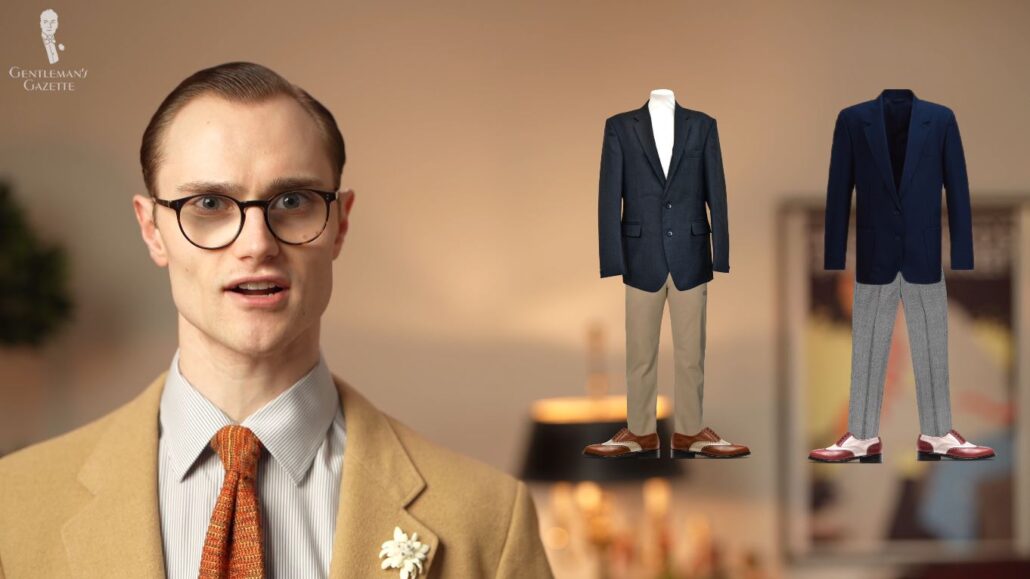
So, we hope that today’s guide has encouraged you to go from merely being a spectator of this shoe style to picking up a pair yourself. Just make sure that they correspond well with the other elements in your wardrobe.
Outfit Rundown
Today, I am wearing a pair of spectator shoes. These are a bit on the bolder side as they feature tan leather, but also a herringbone fabric. These shoes are from the boutique retailer Strange Island, which was part of our $100 to $300 dress shoe roundup.
To tone down the high-fashion look of these shoes, I replaced the red laces they originally came with with a gray pair from Fort Belvedere. These laces harmonize better with the grayscale coloring in the herringbone fabric and also make them acceptable to wear with a wider variety of outfits and, indeed, I’ve gone for a gray and brown color feel elsewhere in my outfit today.
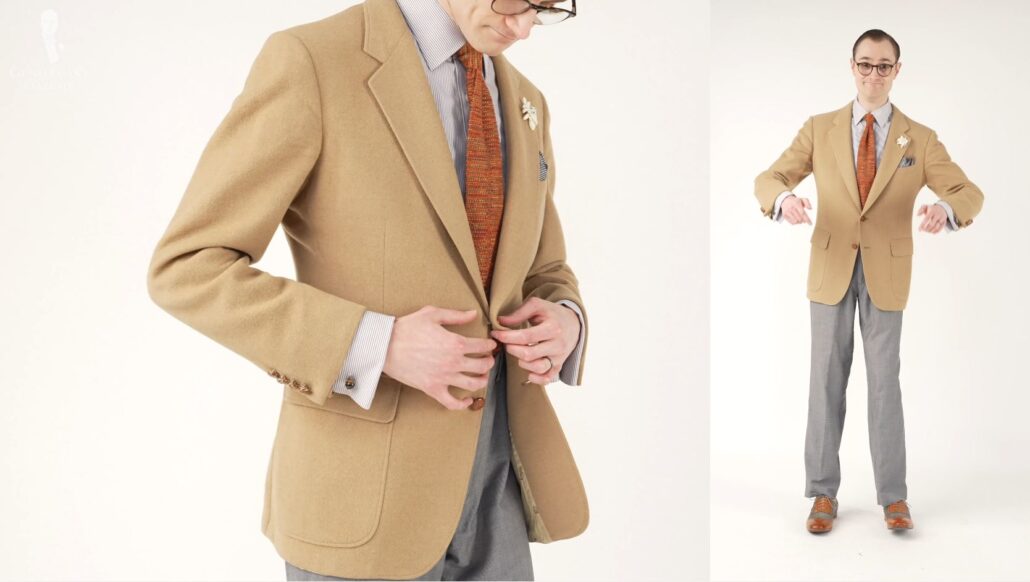
We’ll start with my vintage camel hair jacket, whose tan football buttons harmonize particularly well with the color in the shoes. My French cuffed shirt features fine stripes in gray and white and, in the cuffs, I’ve got gold-plated, sterling silver eagle claw cufflinks from Fort Belvedere with tiger’s eye as the stone to reinforce the brown color feel.
My trousers are gray in color, but they also feature a very subtle checked pattern in their weave. My pocket square today is also in a black and white herringbone pattern to directly harmonize with the fabric in the shoes.
My boutonniere also from Fort Belvedere is our popular edelweiss design in a cream color with accents of a grayish color as well. My modal knit tie features colors of gray, brown, yellow, and orange, and my Fort Belvedere socks are in charcoal gray with orange accents so these two elements tie together nicely.
For all of the Fort Belvedere accessories I’m wearing, as well as a wide array of others, be sure to visit the Fort Belvedere shop.
How do you like spectator shoes? Would you wear them today? Let us know your thoughts in the comments section!
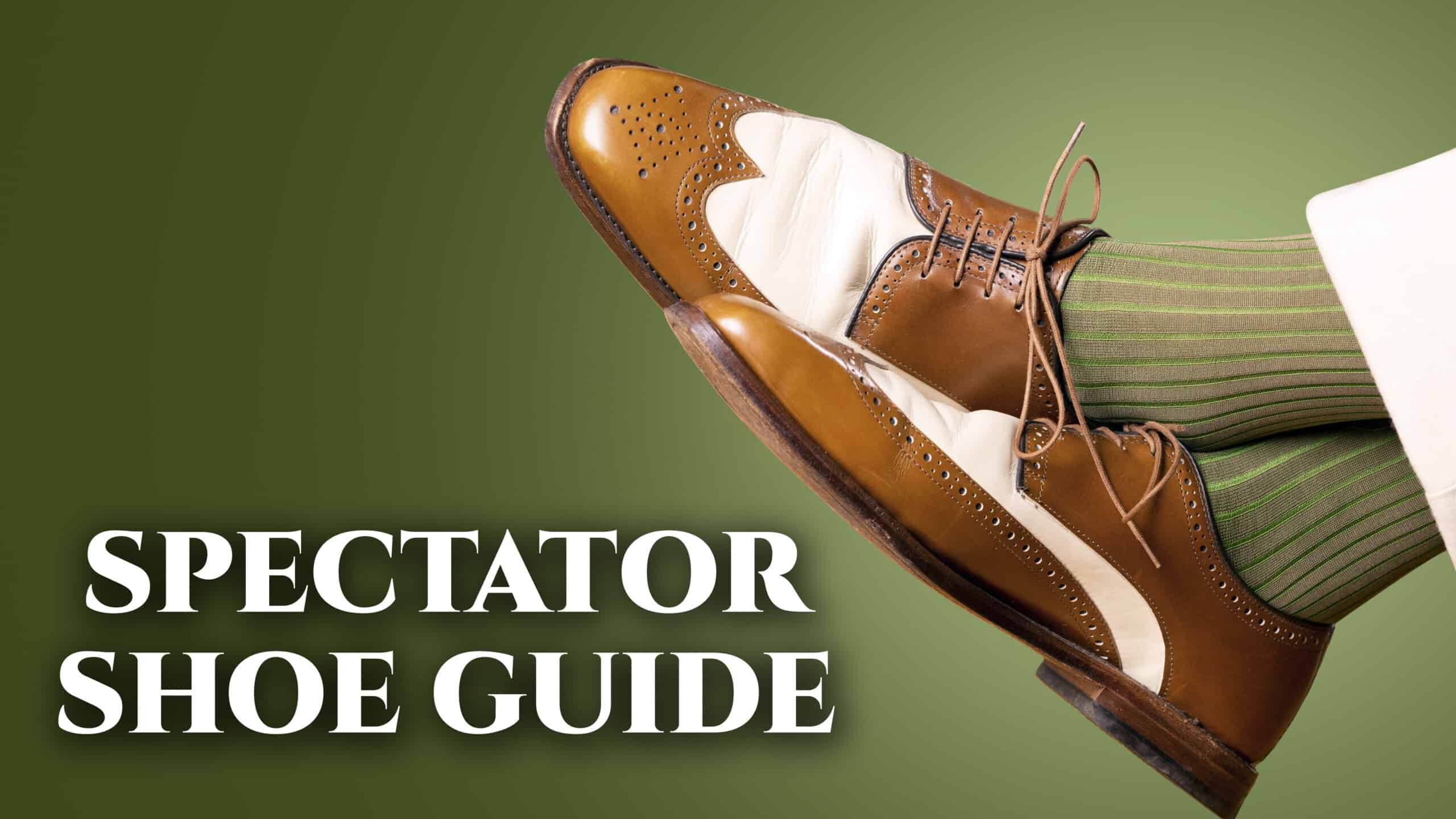

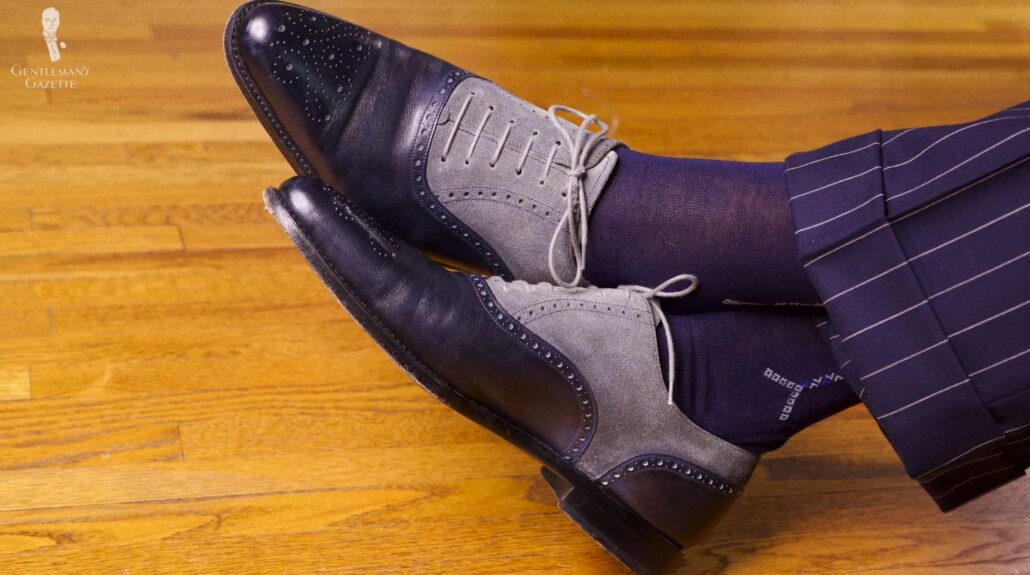
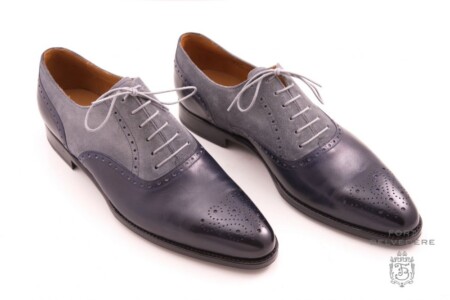
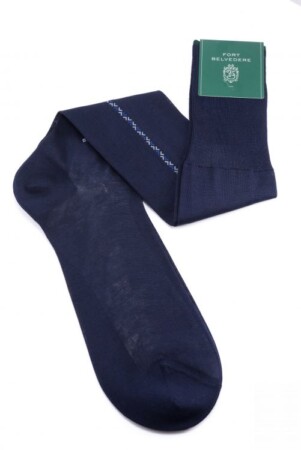
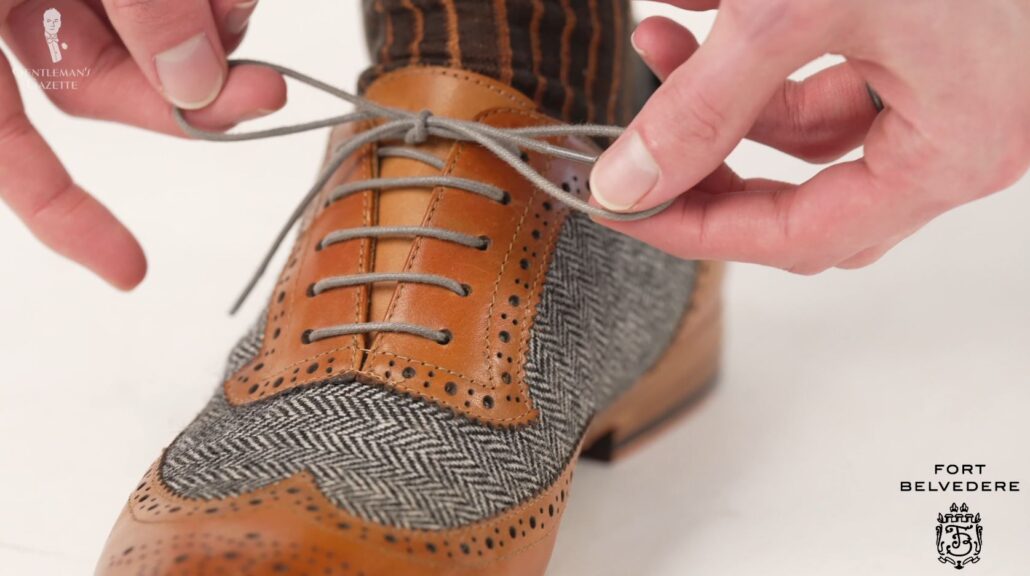
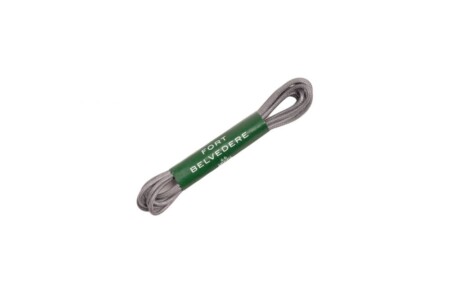
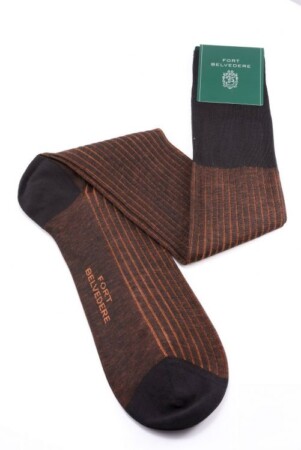
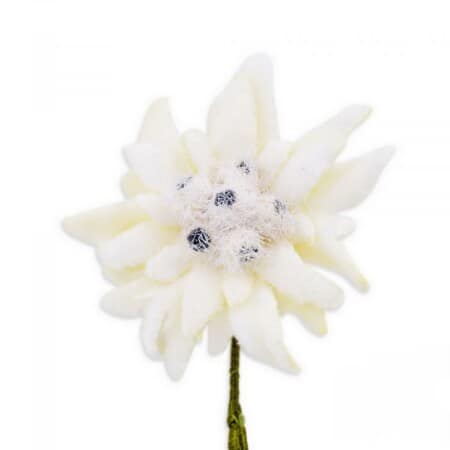
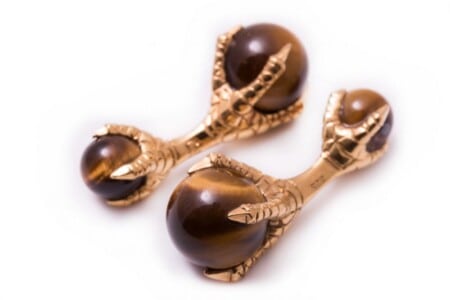
Great being a participant in spectators. They’re the shoe that fits when you want to go full bore Nathan Detroit.
I have a pair of classic Johnston and Murphy “Waverly” full brogue black/white spectators I purchased about 12 years ago; a pair of Brooks Brothers penny loafer style black/white spectators about 10 years ago (my favorites); a pair of Allen Edmonds “Ramseys” about 10 years ago; and a pair of J&M “Heltons”, a very casual brown/white spectator that I still got compliments on before I retired from work in 2020. I flirty with the “Knucky Thompsons” when Boardwalk Empire was running but decided I had enough specs. I love them all and although I think I’m finished, I do visualize a pair of dark burgundy, white vamp penny loafer style if I can find them. At 68 and retired, I can get away with wearing them. Great article!
I usually wore black and white spectators when I played with a jazz band for 30 years, whose members had a reputation for their vintage style, which included flashy footwear. I still see image as a very important part of any entertainment presentation.
Two questions–I would love to include spectators in my wardrobe, but shudder to think of the pain it would be to shine/polish the darker color and avoid getting the dark polish on the lighter color (either during the application of the polish or the during the buffing stage). Any suggestions?
Second question–will you consider doing a segment on the size/depth of a pair of trouser cuffs? Sven seems very happy with a trouser cuff depth that I have never seen anywhere else. Enlighten me?
If you are applying your cream and polish with a finger covered by a cloth, then it’s a surprisingly simple task to perform as polishing in this style will provide the greatest control over where the polish goes. Essentially, there is no magic trick to doing it well, it’s just a case of taking a little time and care to ensure you get your spectators to the state you’re looking for. If you like a mirror shine, then I’d stick to just the largest areas where you can apply this – most likely the toe cap and heel portions.
To answer your second question, we have an upcoming article that will be of interest to you! Stay tuned and you’ll learn more about Raphael’s trouser cuff options.
YouTube has some good tutorials on polishing spectators. Kirby Allison and some others offer good advice. It’s tricky.
LOVE Spectators. I own three pair! Black with herringbone fabric, brown with herringbone. and grey with grey suede.
Pleasure to read
I WEAR SPECTATORS QUITE OFTEN WHEN THE WEATHER IS NICE. I HAVE HAD MANY MEN AS WELL AS WOMEN COMMENT ON THEM POSITIVELY. HOWEVER MOST MEN SEEM TO BE AFRAID TO WEAR THEM THEMSELVES, BUT THEY WILL WEAR THEM ON THE GOLF COURSE. THE SAME GOES FOR ASCOTS WHICH I WEAR QUITE OFTEN.
“EVERY GENTLEMAN’S” shoe wardrobe “MUST” be equipped with at least one pair of Spectators… if any color combination.